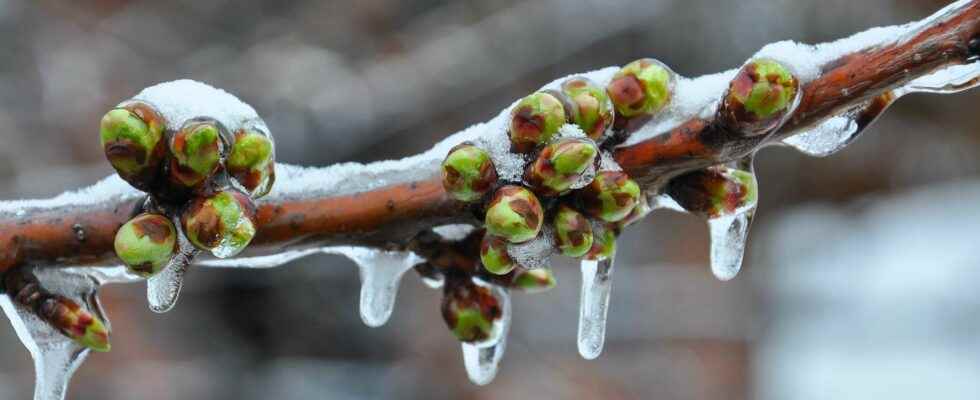You will also be interested
[EN VIDÉO] Our agriculture will soon be affected by global warming Some of the effects of global warming are already being felt. Others are yet to come. The yields of certain crops could thus drop tangibly from 2030 under the effect of rising temperatures, variations in precipitation patterns and high levels of carbon dioxide (CO2) in the atmosphere. This is the conclusion of researchers who have worked on the most efficient climate and crop models of the moment. Maize yields, for example, could drop sharply. (in English) © NASA Goddard
This Friday, the wind is moving north and northeast and the temperatures will drop until Monday. Despite its potentially destructive nature on crops, this winter offensive cannot be described as ” wave cold” however, because the values will not go down low enough and not for long enough.
Frost until Tuesday
The frost will possibly be catastrophic for certain crops between Saturday and Monday: if the frosts will be more widespread on Sunday morning, the coldest morning will be Monday. Up to -5°C expected, but if the snow manages to hold, the mercury will go much lower on these areas. Snow promotes radiation nocturnal, and in this case, it is possible to lose another 5° C! All French regions will be affected, except a small part of the south-east which will benefit from barely positive temperatures.
Next night, very cold air at altitude will invade France: up to -37°C modeled at 500 hPa.
The record in France for April dates from April 13, 1968 with up to -40°C in reanalysis at 500 hPa.
Values of -38 to -40°C have already been observed on several occasions. pic.twitter.com/VEXvaaXlLd— Keraunos (@KeraunosObs) March 31, 2022
This event is reminiscent of last year’s destructive frost, in April 2021an episode recognized as an “agricultural calamity” by the Ministry ofAgriculture. However, the situation for this month of April 2022 will be different and, a priori, less serious: the temperatures will not drop as low, unless the radiation linked to the snow worsens the situation in certain departments.
After the two very risky mornings of Sunday and Monday, the probability of frost will still persist until Tuesday morning but in a more limited way. Temperatures will then rise again from Wednesday and this late cold period will be over.
[MAJ, 31/03] The modeling of tree production losses still considers a major risk on the ????????.
Changes since yesterday:
– ↗️ damage in the west, Mediterranean hinterland & Alsace.
– ↘️ damage in the Paris basin (cloud layer).#gel#snow#FrAgTwpic.twitter.com/dshQ8NElH9— Dr. Serge Zaka (Dr. Zarge) (@SergeZaka) March 31, 2022
Worrying situation for fruit and vegetables
Vincent Guyot, cereal farmer and beet producer near Saint-Quentin in the Aisne, is particularly worried: ” The risk is very high when the seedling emerges from Earth, i.e. currently. It only takes a freeze at -1 or -2°C to burn or cut the stalk that has just emerged. This will be decided on a plot-by-plot basis, depending on the exposure and altitude of each plot. At 3 or 4 km apart, we can have a 3°C difference “.
And if the presence of snow can cause temperatures to drop, it can also act as an insulator for plants: “ If there is 5 to 10 cm of snow on the ground, it will perhaps protect the plants, in the same way as we asparagus the flowers in advance of a frost in arboriculture. But if there is no snow, and the plants suffer frosts at -4 or -5°C on bare ground, then it will be very complicated! There is no protection for the beets. For the vines, we can light candles, but we don’t “.
In the case of a destructive frost, the only solution will then be to re-sow, but the farmer specifies that ” the earlier you sow, the better the yield; and the later you sow, the more you lose yield. I sowed on March 20, then we had 10 days of spring conditions and the beets germinated very quickly, and if the frost destroys the plants, it will be necessary to wait for the return of dry soil to sow again.u”.
About the vines, the risk is mainly in the west in the early grape varieties: in the Loire Valley, near Bordeaux and sometimes in Burgundy. In the north of France, the stage of development is not yet sufficiently advanced and the damage will be very limited. On the other hand, the loss is likely to be significant on the harvests of cherries (already affected last year), but also on strawberries, raspberriesMirabelle plums, peaches, apricots or even kiwi fruit. The only solution is the installation of heating systems, which are very energy-intensive and costly for producers.
Less problematic for cereals
About the cerealsthe situation is not worrying: The stage is not advanced for the wheatwhich is normal at this time of the year because their growth depends on the light of the day. The rod does not exceed the centimeter, and it should not be a problem even with -3 or -4 ° C. And there will be no major consequences if the rapeseed freezes, because we are at the beginning of flowering and this lasts a month, the rapeseed will be able to compensate with the following flowers “.
Support your independent scientific media: discover our subscription formulas!
4 good reasons to subscribe to Futura on Patreon:
- A site without any advertising from 3.29 euro per month.
- It is without commitment.
- Access to priority content, in preview, just for you.
- You support our business in the best possible way. A real motivation for us!
Interested in what you just read?
